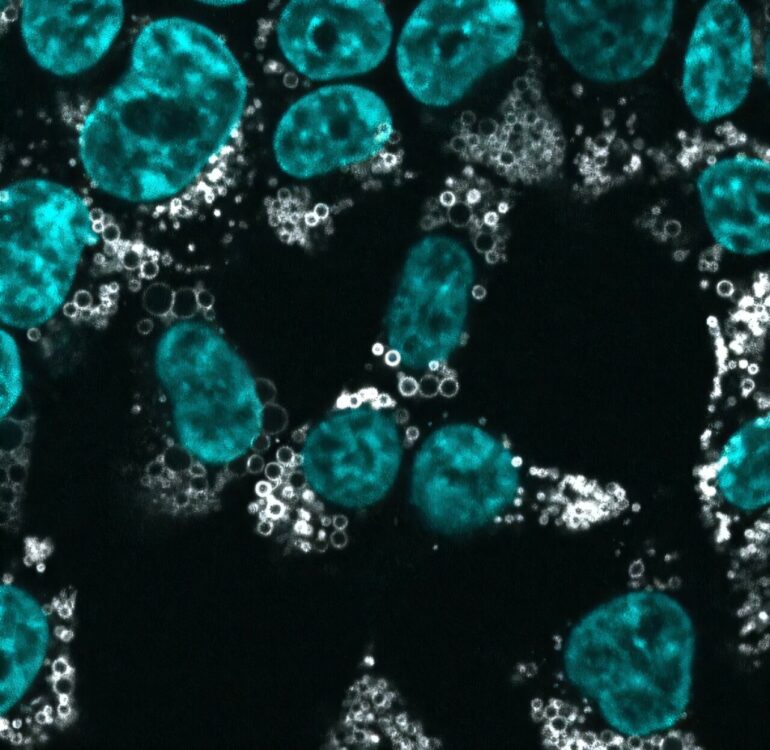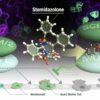Like workers at a factory or office, proteins in a cell must be in the right department to do their jobs. But scientists have yet to fully map the cell’s organization, much less determine how these cellular “employees” may be reassigned in a time of crisis or change. A hostile takeover by a virus, for example, can send a cell’s proteins to new stations, from which they may either serve the pathogen’s aims or help the cell as it attempts to resist the infection.
A new method, described Dec. 31 in Cell and devised by a multidisciplinary team at the Chan Zuckerberg Biohub San Francisco (CZ Biohub SF), captures spatial organization across the entire cell at an unprecedented level of detail. Their approach maps the majority of a human cell’s roughly 10,000 kinds of proteins according to the organelles and other compartments containing them, providing a crucial reference to understand how our cells are built. The team also applied their method to characterize how a portion of these proteins relocate during viral infection.
The new work is an example of “spatial proteomics,” a burgeoning field that was named the 2024 “Method of the Year” by the journal Nature Methods. Spatial proteomics aims to increase our understanding of how proteins function by building detailed maps of their locations in cells and tissues.
Researchers typically study cellular responses by looking for increases or decreases in the quantity of particular proteins or their precursor mRNA molecules, as the cell “hires” or “fires” proteins to adapt to changing circumstances. In the experiments reported in the article, however, changes in proteins’ location occurred largely independently from changes in their abundance — suggesting this conventional approach captures only a portion of a cell’s response.
“If we want to get the full picture of what’s going on in cells during disease, we need to think not only about measuring abundance, but also changes in spatial organization,” said senior author Manuel Leonetti, head of the Intracellular Architecture group and director of systems biology at CZ Biohub SF.
One cell, 19 compartments, thousands of proteins
Each of our cells is built from a collection of about 10,000 kinds of proteins. Researchers have long had the ability to track the positions of small numbers of these proteins under the lens of a microscope. However, capturing the full scope of their locations in the cell has remained more challenging, let alone following how they change locations as a cell adapts to different conditions.
In previous work, Leonetti’s team developed a platform called OpenCell that used microscopy to map the precise cellular location of more than 1,300 kinds of proteins under baseline conditions. But to define the location of proteins at a more comprehensive scale, and across different cellular states, they needed a new approach.
Rather than focus on precisely pinpointing the location of particular proteins one at a time, their new approach, Organelle Profiling, considers them as constituents of a cell’s organelles, its liquid interior (the cytosol), and other internal structures. In the new study, they attached unique molecular tags to 19 such compartments that collectively account for the entire cell.
After tagging, they forced cells through a narrow syringe, gently breaking them open while keeping internal structures intact. Using antibodies designed to recognize the tags, they extracted the individual compartments before determining their protein composition with mass spectrometry, an analytical technique that identifies compounds based on their electrical charge and mass.
Discover the latest in science, tech, and space with over 100,000 subscribers who rely on Phys.org for daily insights.
Sign up for our free newsletter and get updates on breakthroughs,
innovations, and research that matter—daily or weekly.
From within these compartments, they identified and analyzed the relative location of more than 8,000 unique kinds of proteins. The work was done in close collaboration with CZ Biohub SF’s Mass Spectrometry platform, led by co-senior author Josh Elias.
The same kind of protein could appear in multiple compartments, in some cases showing up faintly when a bit of an organelle was extracted along with a neighboring compartment. The team then looked for proteins with similar profiles. In their analysis, they built a network that treats similar proteins as connected, leading to the appearance of well-delineated clusters of proteins that define individual compartments — endoplasmic reticulum, cytosol, mitochondria, and so on.
Some proteins had significant connections that straddled compartments. These proteins, which the researchers interpreted as being located at compartment boundaries, help the compartments work together to support the cell, according to Duo Peng, a senior computational biologist at CZ Biohub SF.
“With most previous technologies, it’s very hard to resolve proteins at the interface of organelles, but ours does that very well,” said Peng, co–first author of the new paper who led data analysis.
In the end, the team generated a map that organizes proteins according to their relationships with one another — a high-resolution view that spans the entire cell. When they compared this map to previously collected data about the proteins, they found it matched up very well.
“What’s really cool is that our method can provide a lot of information with only a rather small number of experiments. This is powerful because it allows us to easily compare how a cell remodels itself when conditions change,” Leonetti said.
Revealing relocation
To next see how cells can reconfigure themselves internally in response to change, the team exposed the cells to OC43, a coronavirus that causes the common cold, then repeated the Organelle Profiling analysis. This revealed two distinct shifts: 633 kinds of proteins relocated, meaning that their relationships with other proteins in the cellular map changed significantly. Meanwhile, the overall abundance of 429 kinds of proteins increased or decreased. But, to the team’s surprise, only 54 underwent both types of changes.
Marco Hein, a co–first author who led the project while he was a fellow in Leonetti’s Biohub group, says he was struck by how little these two types of changes overlapped.
“If we look at protein location, we really get a conceptually distinct type of information that wouldn’t be available if we did the easier thing and measured only protein abundance,” said Hein, who now leads his own group at the Max Perutz Labs in Vienna, Austria.
The shifts in location after OC43 infection provided new clues to the underlying biology. In particular, the relocation of proteins involved in a form of programmed cell death called ferroptosis led the researchers to show that increasing ferroptosis promoted infection, while decreasing it inhibited the virus. This shows that ferroptosis plays a central role in controlling infection, and could be a target for the development of new antiviral therapies.
The researchers are continuing to look for other examples of telltale protein shuffling, both in other viral infections and in Alzheimer’s disease.
“We think our Organelle Profiling method could reveal changes in the spatial organization of cells across a wide variety of diseases,” Leonetti said. “This could give us many new clues about the biological mechanism of these diseases, and new ideas about how to fight them.”
In the meantime, the group has made the data they have generated via Organelle Profiling freely available to other scientists. The team at CZ Biohub SF is also planning to offer the tools they used, including cells and reagents, to the scientific community. A streamlined software program they are developing will allow other researchers to more readily map the compartmentalization of proteins in the scenarios they study. In return, the team hopes others will contribute their data openly to build better models of how our cells are internally organized.
“Our method strikes a really nice balance between obtaining detailed data and doing so in a tractable way,” Elias said. “This is something that a lot of different labs could use to do quite interesting work.”
More information:
Marco Y. Hein et al, Global organelle profiling reveals subcellular localization and remodeling at proteome scale, Cell (2024). DOI: 10.1016/j.cell.2024.11.028
Provided by
Chan Zuckerberg Biohub
Citation:
Scientists create comprehensive map of protein locations within human cells (2025, January 9)



